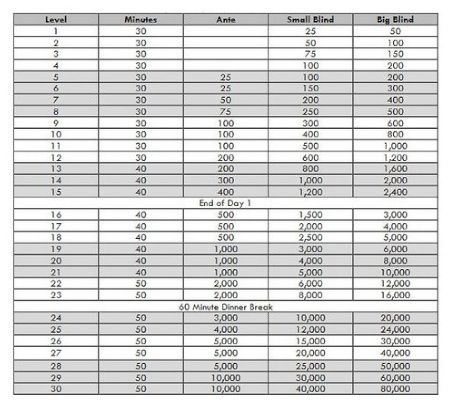Good Poker Tournament Structure
Blind structure. Usually you want to increase the blinds by 50% from level to level, so that the big blind doubles every two levels. If you double it every level, it's a fast structure. Example: 100/200 - 200/300.
- Buy a poker chip set. The most realistic affordable size is 500 chip 11.5 gram (0.4 oz) weight set.
- Blind Structure Calculator. The blind structure (or schedule) is one of the most important details of running a successful tournament. Gradual increases of the blinds at each level and finishing on time are characteristics of a good blind structure. To calculate a blind structure, the minimum information you need is the number of players, target duration, and the starting blind level (which is usually the smallest.
Home Poker Tournament Structure
I'm sure you're capable of buying beer and nuts. If your friends want coke and sweets, fine, that's what you get them. Mussels and red wine? Do it.
I won't touch on that part of your poker night. You should know your friends. However, there are a few small things that may ruin the fun.
If you don't set up a good blind structure and sensible chip values, people will be confused and annoyed. Do it well and your home tournament will run smoothly.
Blind periods
In a home game, I would go with 20 minute periods at least, seeing how slowly most people deal.
If you think the tournament will drag on too long, it's probably better to adjust the starting stacks than the blind periods.
Ending time
There's no way of knowing for sure when a tournament will end, but here's a rule of thumb that will help you avoid disasters.
The tournament will end in the blind period where the big blind is more than 5% of the total chips.
Example: If 10 players start out with 10,000 in chips each, the total chips are 100,000. Hence, the tournament will end in the period where the big blind reaches 5,000.
Again, this is a very crude rule, but you will avoid having to stay up the whole night - unless you want to.
Blind structure
Usually you want to increase the blinds by 50% from level to level, so that the big blind doubles every two levels. If you double it every level, it's a fast structure.
Example: 100/200 - 200/300 - 200/400
On the other hand, you should probably use some 'natural' blind levels that people expect, rather than rigidly doubling every two levels.
Example: rather than 200/400 - 300/600 - 400/800 - 600/1200, you might want to go with 250/500 - 400/800 - 500/1000 - 750/1500.
On the third hand, you should avoid mixing in small chip nominations late in the structure. Blinds of 1250 or 3725 will give your friends a really bad headache.
Example: To avoid this, it's quite fine to do 300/500 instead of 250/500, or 800/1500 instead of 750/1500.
There are a lot of parameters, but you'll be fine if you avoid the worst mistakes.
Example blind structure
1. 25/50
2. 50/100
3. 75/150
4. 100/200
5. 150/300
6. 250/500
7. 400/800
8. 500/1000
9. 800/1500
10. 1000/2000
11. 2000/3000
12. 2500/5000
13. 4000/8000
14. 5000/10,000
Starting stack
Poker Tournament Structure Template
The standard starting stack would be 100 to 200 times the big blind of the first blind level.
Example: If you start with blinds 25/50, you could use a starting stack of 5,000 or 10,000.
The starting stack affects both how deep stacked the players are and the length of the tournament. Regarding the ending time, see above.
If you want to start with deep stacks to get some real play early on but don't want to play all night, you could use a faster structure.
Example: To get a faster structure, remove level 1, 3, 5 etc. from the blind structure above.
Chip nominations

To make the betting easy, chip values should go up by a factor 4 or 5 between each step.
Example: Avoid using both 100 and 200 chips. It gets messy.
Example: Comfortable chip nominations for the above blind structure would be 25, 100, 500 and 2000. If your people find 2000 too weird, you can go with 1000 or 5000 instead.